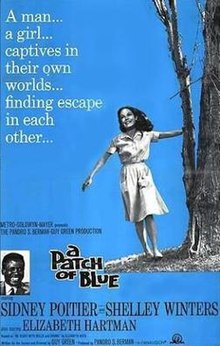| A Patch of Blue | |
|---|---|
 Promotional movie poster for the film | |
| Directed by | Guy Green |
| Screenplay by | Guy Green |
| Based on | Be Ready with Bells and Drums 1961 novel by Elizabeth Kata |
| Produced by | Guy Green Pandro S. Berman |
| Starring | Sidney Poitier Shelley Winters Elizabeth Hartman Wallace Ford |
| Cinematography | Robert Burks |
| Edited by | Rita Roland |
| Music by | Jerry Goldsmith |
| Distributed by | Metro-Goldwyn-Mayer |
Release date |
|
Running time | 105 minutes |
| Country | United States |
| Language | English |
| Budget | $800,000 |
| Box office | $6,750,000(rentals)[1] |
A Patch of Blue is a 1965 American drama film directed by Guy Green about the friendship between an educated black man (played by Sidney Poitier) and an illiterate, blind, white 18-year-old girl (played by Elizabeth Hartman in her film debut), and the problems that plague their friendship in a racially divided America. Made in 1965 against the backdrop of the growing civil rights movement, the film explores racism while playing on the idea that "love is blind."
Shelley Winters won the Academy Award for Best Supporting Actress, her second win for the award, following her victory in 1959 for The Diary of Anne Frank. It was the final screen appearance for veteran actor Wallace Ford.
Scenes of Poitier and Hartman kissing were cut from the film when it was shown in film theaters in the Southern United States.[2] These scenes are intact in the DVD version. According to the DVD audio commentary, it was the decision of director Guy Green that A Patch of Blue be filmed in black and white although color was available.
The film was adapted by Guy Green from the 1961 book Be Ready with Bells and Drums by the Australian author Elizabeth Kata. The book later won a Writers Guild of America award. The book's plot has a slightly less optimistic ending than the film.
In addition to the Best Supporting Actress win for Winters, the film was nominated for Academy Awards for Best Actress in a Leading Role (Elizabeth Hartman), Best Art Direction-Set Decoration (Black-and-White) (George Davis, Urie McCleary, Henry Grace, Charles S. Thompson), Best Cinematography (Black-and-White) and Best Music (Original Music Score). Hartman, 22 at the time, was the youngest Best Actress nominee, a record she held for 10 years before 20-year-old Isabelle Adjani broke her record in 1975.[3]
- ^ "Big Rental Pictures of 1966". Variety. January 4, 1967. p. 8.
- ^ Canby, Vincent (April 5, 1966). "'A Patch of Blue' Draws in South". The New York Times. p. 42. Retrieved November 22, 2023.
- ^ "A Patch of Blue". Movies & TV Dept. The New York Times. 2012. Archived from the original on October 18, 2012. Retrieved December 26, 2008.